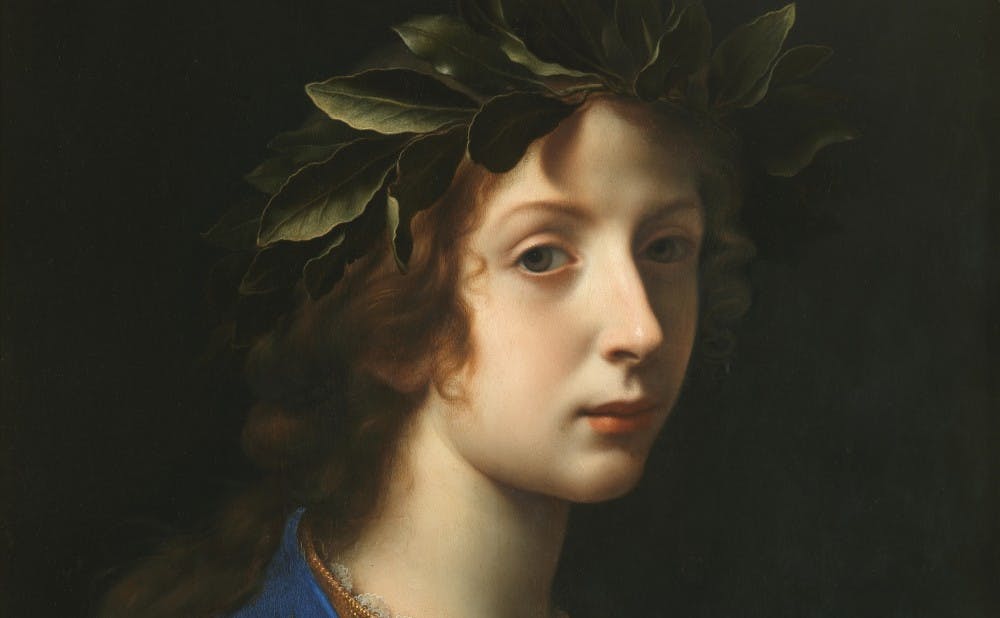A young woman wreathed in a laurel crown gazes at you from across the room. She is framed in golden opulence and surrounded by an expanse of blue. Her name is Poesia.
Carlo Dolci created this portrait of “Poetry” that hangs in the Nasher Museum of Art. One of the first and only exhibits in the U.S. dedicated to the "Old Master," “The Medici’s Painter: Carlo Dolci and 17th Century Florence” will be on view Aug. 24 to Jan.14. Tickets are free for Duke students and $7 for faculty, staff and alumni.
Passing through the rooms of the gallery, visitors will meet the eyes of religious figures and those of the painter himself. Dolci's self-portrait shows a quiet and introspective man holding a sketch of himself painting. From the sketch, viewers get a glimpse of Dolci as an artist; he works with immaculate technique and an undivided concentration.
“I really like his self-portrait because it is so complex,” Assistant Curator Molly Boarati. “It shows many different levels of who Dolci the artist was. You get a sense of his character but also his seriousness in his art.”
While technique and concentration are both essential traits of any great painter, what sets Dolci apart from his contemporaries is his spiritual devotion combined with the tireless pursuit of highly refined details. He would use brushes with only a few bristles to build an area and was known to pray in between brushstrokes. As a result, it often took him years to complete a painting.
In “Angel of The Annunciation,” the golden embroidery on the angel’s garment appears to be sewn onto the canvas. Gemstones and fabrics take on realistic textures, appearing reflective or transparent. Dolci also used powdered gold mixed with oil for halos, giving his religious figures an added air of spirituality and presence.
Dolci’s process of rendering every detail was his form of spiritual meditation. A deeply religious man, he represented his own connection to God and the divine in the emotional lives of his subjects.
“His purpose of the picture was to inflame the faith of the viewer. And he vowed when he was very young that he would only paint religious subjects,” Nasher Museum Director Sarah Schroth said.
Depictions of the Virgin and Child and numerous saints hang from the many rooms of the Nasher gallery, but in one room, visitors get to experience Dolci less as a man of deep faith and more as a father and teacher. One of the last rooms of the exhibit contains an example of Dolci’s handwriting and an iPad containing his sketchbook. Inside, visitors will find Dolci’s loose and casual sketches alongside his children’s replicas. Eventually, the Nasher is hoping to put paper and pencils in the space for visitors to do their own sketching.
“Sketching was so important to Dolci as well as to the tradition of art history in Florence so it seems appropriate to show his sketches to also encourage others to do so,” Boarati said.
Schroth and her team thought carefully about the design of the gallery. Because the exhibit differs slightly from the first one in the Davis Museum at Wellesley College, which obtained the pieces from lending institutions, things had to change to accommodate the space at the Nasher.
“We wanted to guide the visitor through in one main direction and really astound them with the masterpieces,” Boarati remarked.
The gallery was divided into several rooms to convey a sense of intimacy and complement the smaller size of Dolci’s works. Schroth also made sure that Dolci’s best works would be highlighted by placing them in places where viewers can see them through doorways.
The entire exhibit houses around 34 pieces of Dolci’s work borrowed from world-class institutions like the Louvre and the Metropolitan Museum of Art. This show is the first exhibit dedicated to Dolci in the U.S. and provides a rare opportunity to rediscover an "Old Master" who had been forgotten by the public until now.
Ironically, Dolci was hugely popular in his time and had many followers who produced copies of his work. Many of these copies were wrongly attributed to Dolci and people assumed that he was not a good painter. His reputation further declined when John Ruskin, a highly influential critic, wrote negatively about his work. Coupled with the movement towards reason and away from religious devotion during the Enlightenment, Dolci was pushed further into obscurity.
“I think that for anyone who has never heard of Dolci or seen his work, you’re in for a great treat,” Boarati said. “This is a wonderful discovery and it’s something that can really only be explored by seeing the works in person.”
Correction: An earlier version of the article incorrectly stated the ticket prices for the exhibit. The Chronicle regrets the error.
Get The Chronicle straight to your inbox
Sign up for our weekly newsletter. Cancel at any time.

